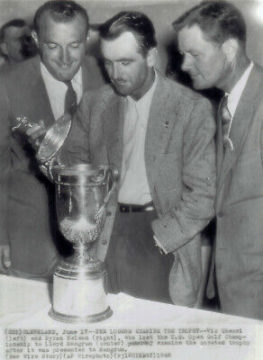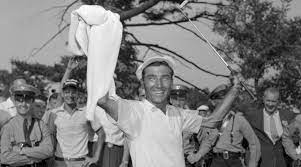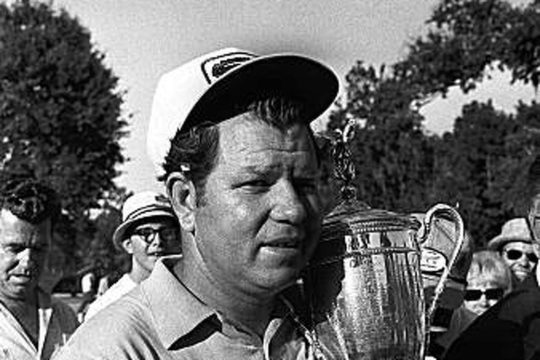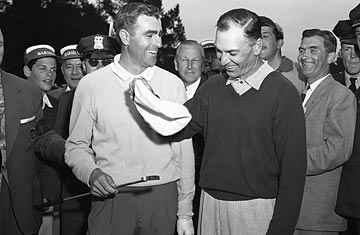BROOKLINE, Mass. – Back in the Dark Ages, the Holy Catholic Church faced a dilemma; a branch of the religion embraced poverty as a defining virtue, in direct opposition to the rest of the monastic orders, triggering a century-long power struggle within the church. The teachings of St. Francis of Assisi were the genesis of the discord, and during the Saint’s life he founded what became known as the Franciscan Order, still to this day one of the strongest and most popular branches of Christianity.
American golf has its own St. Francis: Francis Ouimet, the 20-year-old amateur and local Boston boy who went toe-to-toe with the golf giants of the age, Britain’s Ted Ray and Harry Vardon, and slayed them in the most dramatic fashion at the Country Club, this year's US Open venue. With a rosy-cheeked 10-year-old boy named Eddie Lowery on his bag, Ouimet fileted Vardon and Ray by five and six shots respectively in an 18-hole playoff for the 1913 US Open and forever entered into golf immortality. Already chronicled in movies and books, Ouimet’s story will continue to be told and retold in every form of media now known or hereafter discovered.
Although Ouimet is regarded as the patron saint of miracle U.S. Open winners, his scions shine less brightly. There have been a handful of unexpected, unheralded -- perhaps even “miraculous” -- US Open champions, but they are far less celebrated than Ouimet, though their victories are no less noteworthy or impressive.
For our yearly US Open history lesson, let’s highlight some of the lesser known, but equally worthy champions.
1933 – Johnny Goodman, North Shore Country Club
No less a personage than Grantland Rice, a paragon of sports writing, chronicled the then U.S. Open record-tying 66 Goodman fired in the second round to vault into a lead he never relinquished en route to winning the 1933 Open. Spending most of the week shadowing his friend Bobby Jones, Rice wrote in his column for the following morning’s paper:
"I have seen any number of dramatic moments in open golf championships but I have never seen anything that could quite equal all the compressed drama of Johnny Goodman’s amazing round today." – June 10, 1933, Spokane Spokesman Review.
As an aside, Jones quipped to Rice as he was writing, “This is a good time to get in there that Goodman defeated me at Pebble Beach.”
Goodman was the last amateur to win the US Open, running away and hiding after three days to the tune of a six-shot lead. Even a closing 76 was enough for a one-shot victory over Ralph Guldahl (who would win back-to-back U.S. Open championships in 1937-38) and two strokes over Craig Wood (who won his lone US Open title in 1941). It’s not Vardon and Ray, but Wood and Guldahl won a combined three U.S. Opens where Vardon and Ray captured two. Vardon won the 1900 U.S. Open at Chicago Golf Club, while Ray claimed the 1920 Open at Inverness.

1946 – Lloyd Mangrum, Canturbury Golf Club
History could bestow upon him the moniker of “Lloyd Mangled” because the ’46 US Open champion earned two Purple Hearts in WWII. Where many American professional golfers took cushy head pro jobs on army barracks layouts, Mangrum was wounded landing at the Allied invasion of Normandy, was wounded again at the bloody Battle of the Bulge, and then was injured a third time shortly thereafter when a jeep overturned on him.
Upon returning to the States for the first post-war Open, Mangrum vaulted into contention at Cleveland’s Canterbury Golf Club with a third round 68, putting him one shot behind popular bon vivant Vic Ghezzi and ’39 Open champion Byron Nelson. Over the final round and not one, but two, 18-hole playoffs, the three players jockeyed back and forth, with slings and arrows and outrageous fortune inflicting wounds on all three.
Nelson frittered away two chances to win the tournament in regulation play: first, when his caddie incurred a one-stroke penalty by accidentally kicking Nelson’s ball, and again when Nelson bogeyed the last two holes of the final round, dropping into the tie with Mangrum and Ghezzi. And although Ghezzi hung around, percolating into and out of the lead, he could never quite manage to break away. Meanwhile Mangurm also flushed a four-shot lead in regulation play to open the door for Ghezzi and Nelson in the first place.
After firing 72s in the first playoff round on Sunday morning, the three teed off again for another 18 holes in the afternoon. Outraced a thunderstorm to the safety of the clubhouse, Mangrum birdied three out four holes between 13 and 16 to break out of the logjam and seize a lead he never relinquished.
1954 – Ed Furgol, Baltusrol Country Club (Lower Course)
"I didn’t win despite my handicap, but because of it – just as Hogan came back from that automobile accident, and Babe Zaharias came back from a cancer operation." — Ed Furgol after winning the 1954 U.S. Open at Baltusrol
Ed Furgol, hailing from sleepy Utica, N.Y., won the US Open despite a withered left arm that was ten inches shorter than the other and while working as a head professional at a local St. Louis country club. They let him play four tournaments a year, including the Open and the PGA Championship. As I wrote a few years ago:
Ed had already tried the Tour and had flunked out. Now he was marking time as a club pro in St. Louis. He had a wife, a mortgage and memories of glory days, but mostly he had fifty cent an hour lessons with Mrs. Bell, trying to teach her not to top the mid-irons.
But as they say in the infomercials, “But wait! There’s more!” When Furgol qualified in 1954, he was considered so much of an afterthought - a ceremonial golfer at best, window dressing to Sam Snead or Ben Hogan - the local St. Louis newspaper didn’t even send a reporter to cover the tournament, his sponsor Dunlop did not arrange a courtesy car to drive him to and from the course, and when caddies were assigned, there wasn’t a Baltusrol regular available, just a random local looking to earn some quick cash toting a bag for the weekend.
“Not only did he know nothing about the course, he had very little knowledge of golf,” Furgol explained in a Sports Illustrated article previewing the 1955 Open. “At no time during the entire three days and 72 holes of golf did I ask him for one bit of advice. On two or three occasions I pleaded with him to keep my iron clubs clean – he would leave the grooves and face of the clubs dirty.”
Nevertheless, when Nelson and Hogan faded, it left the stage to Furgol, who outlasted rising star Gene Littler by one stroke and Lloyd Mangrum and Dick Meyer by two.
Strictly as an aside, Furgol did have movie star good looks going for him, being a dead ringer for Bela Lugosi, the iconic portrayer of Dracula in the movies of the day.

1955 – Jack Fleck, Olympic Club (Lake Course)
Lightning struck in the same place two years running as another unheralded golfer came out of nowhere to stun the golf world and seize the national championship from the grasp of a golfing immortal. But it was one stroke of luck and one chance encounter that may have led Fleck from also-ran status to the winner’s circle.
Until the ’55 Open at San Francisco’s Olympic Club, Fleck hadn’t exactly made a name for himself on the PGA Tour. His story seems an amalgam of Ed Furgol’s and Lloyd Mangrum’s combined. Like the Furgol family, the Flecks were a humble family impoverished by the Great Depression (their Midwest farm suffered greatly during the ‘20s and ‘30s). Like Mangrum, Fleck was a veteran of the heaviest World War II fighting, serving as a Navy quartermaster and sending rockets into the enemy off Normandy’s Utah Beach. And again like Furgol, he was a club pro, in Davenport, Iowa in Fleck’s case. Fleck bandied about the qualifiers, getting a start here or there, but by six months into his career on Tour, he was struggling and searching for answers. Desperate for a spark, he wrote to Ben Hogan, winner of four US Opens by that time (five if you count the 1942 “Hale America Open,” as Dan Jenkins does), asking Hogan for a new set of Hogan’s irons.
The new clubs were not even available to the public then; Hogan himself had to deliver the wedges to Fleck at the tournament. Imagine his surprise when the penny dropped: Upon completing his final round and thinking he had won his fifth Open, Hogan presented the ball to Joe Dey, the USGA’s executive director and museum curator saying, “This is for Golf House.” He then retired to the clubhouse for a celebratory interview when it was rudely interrupted with surprising news. Not only could someone still tie Hogan if he carded two birdies in the final four holes, it was the journeyman/club pro using Hogan's new prototype clubs.
We don’t know what Hogan thought, but we do know what he said: “I hope he makes three birdies or one. I don’t want a playoff.”
Hogan didn’t get his wish -- or his fifth Open. Fleck with, according to him, an angel on his shoulder, tied Hogan, and then defeated him in the following day’s 18-hole playoff. The angel, according to Fleck, was God -- the Lord himself. It seems an elderly gentleman came into Fleck’s pro shop one day and congratulated him on qualifying for the Open. Mind you – Fleck had to go through every stage of qualifying to earn his spot, a remarkable achievement still regarded by USGA officials as one of the greatest surprise victories in Open history. The gentleman continued by saying, “You're doing good on Tour.”
In actuality, Fleck had been floundering on Tour, and Fleck told the gentleman that.
"Don't you play to win?" Fleck said the man asked him, to which Fleck replied "No." The man then replied, "I want you to pray for the power and the strength to compete," and left. "That hit me like a ton of bricks," Fleck admitted.
Then, not long after, Fleck said that he twice heard a voice tell him, "Jack, you're going to win the Open."
It happened twice, in fact. Fleck became convinced it was divine inspiration.
"It was the Lord, and I have to give all the credit to him," he stated. "The good Lord's intervention gave me the strength to win the Open, and I'm forever grateful."

1969 – Orville Moody, Champions Golf Club
Once again, American GIs did the game of golf proud by claiming a US Open. This time it was “Ol’ Sarge,” Orville Moody, perhaps the unlikeliest Open champion since Ouimet. Ol’ Sarge – Staff Sergeant E-6 - won tournaments like the “All Service Championship” and three Korean Opens. But he scored his lone PGA Tour victory on the biggest stage of all, the 1969 Open at Champions Golf Club in Houston. Putting cross-handed and taking advantage of the fact that the best players in golf all spit the bit, Ol' Sarge held off the likes of Miller Barber with his dark glasses and Bob Rosburg who played with a baseball grip.
“Miller Barber has a baffling swing that only a circus clown can imitate,” wrote one irreverent wag. One wonders how it compares to Jim Furyk.
Barber held a three-shot lead as Sunday dawned, but soon Mr. X was foundering and fading, and the rest of the field was suddenly on his heels doggedly and then passing him.
It came down to Moody vs. Rosburg as the back nine unfolded. Playing ahead of Moody, Rossy needed a birdie at the 18th to claim the lead in the clubhouse. But a wayward drive into the rough and chunky 4-wood into a bunker doomed Rossy to bogey and allowed Moody to make a routine par for the title.
2005 – Michael Campbell, Pinehurst No.2
This was supposed to be Retief Goosen’s third US Open victory and his second consecutive. Holding a three-shot lead going into Sunday’s play, Retief looked impregnable. He was the hottest golfer of his age, claiming two US Open in four years over two of the hardest and most venerable courses in America: Southern Hills and Shinnecock Hills.
This was to be a coronation, a ceremonial round that would vault Goosen into the most rarified of air. He was the Iron Goose! The Dockers-wearing zombie! He would slowly, inexporably will you to death.
But in the blink of an eye, there were goose feathers all over the front nine. He was hitting balls into places you couldn’t send a National Geographic photographer to cover. His playing partner, Jason Gore, also collapsed. Plummeting off the leaderboard like their parachutes didn’t open, Goosen and Gore amused themselves playing for $100 a hole.
Goosen actually asked to play for $1,000 a hole, but Gore didn’t have that kind of scratch to gamble.
The stage was left to a surging Tiger Woods and a puzzling stranger, New Zealand’s Michael Campbell. Obscure even in his own country, Campbell rode a wave that some old-timers call an “Open Coma.” His closing 69 held off Woods’s furious back-nine rally, which fizzled with bogeys at 16 and 17.
2009 – Lucas Glover, Bethpage Black
It looked like something a fan would have drawn up on a video game. The leaderboard was star-studded. Tiger Woods! Phil Mickelson! Vijay Singh! And wait, David Duval – seemingly back from the dead! What a leaderboard. Major champions all.
...and then Lucas Glover walked off the trophy.
Glover came out of nowhere as a sectional qualifier and had zero success in all of his prior US Opens. Yet somehow he fended off the biggest names in golf with a combined 25 major championships among them. Lucas was so unknown, every golf writer ended up writing the same story: He likes Clive Cussler spy novels. He reads three or four of them a week. And that's it. That's all we knew about him.
Known more as an afterthought now, the 2009 Open was plagued by torrential rain, ended on a Monday, and produced one of the most milquetoast winners since the early to mid-1930s when guys like Olin Dutra (shaped like a Hobbit he seems more like a grocer than a golfer) and Sam Parks won at Merion and Oakmont, respectively. Glover never had any man-sized hits afterwards and is currently residing in the “Where are they now?" file.
So while we spend the week celebrating Ouimet and his sterling, incomparable legacy, remember those who walked in his shoes and prevailed. Maybe their names aren’t on plaques in the World Golf Hall of Fame and their mementos don’t grace the halls of the USGA Museum, but they still were the epitome of the US Open – survive golf’s most grueling test. Their achievement stands shoulder to shoulder in that respect with Ouiment, Woods, Nicklaus, Hogan, and all the names we do remember.

